A fluorinase enzyme has been discovered that catalyses carbon–fluorine bond formation.
Abstract
Although fluorine in the form of fluoride minerals is the most abundant halogen in the Earth's crust, only 12 naturally occurring organofluorine compounds have so far been found1, and how these are biosynthesized remains a mystery2. Here we describe an enzymatic reaction that occurs in the bacterium Streptomyces cattleya and which catalyses the conversion of fluoride ion and S-adenosylmethionine (SAM) to 5′-fluoro-5′-deoxyfluoroadenosine (5′-FDA). To our knowledge, this is the first fluorinase enzyme to be identified, a discovery that opens up a new biotechnological opportunity for the preparation of organofluorine compounds.
Similar content being viewed by others
Main
The rarity of natural fluorinated products contrasts with the identification of about 3,500 naturally occurring halogenated compounds3. The available fluoride is largely insoluble — for example, sea water contains 1.3 p.p.m. fluoride and 19,000 p.p.m. chloride, which may help to explain why fluorine's biochemistry has hardly evolved.
The toxin fluoroacetate is the most ubiquitious of the small class of organofluorine compounds and has been identified in more than 40 plant species from all of the continents apart from Antarctica4, but its biosynthetic fluorination pathway has not been clearly defined2,5. Fluoroacetate is also produced by the bacterium S. cattleya6 when it is grown in culture medium supplemented with fluoride ions.
We investigated this process of enzymatic fluorination by incubating a partially purified protein extract from S. cattleya with fluoride ions and SAM, and monitored the reaction by using high-pressure liquid chromatography (HPLC). The initial product of fluorination in S. cattleya was shown to be 5′-FDA by reference to a synthetic standard (Fig. 1 legend); the biotransformed compound and standard 5′-FDA co-eluted on HPLC and (after derivatization) had identical molecular masses and 19F nuclear magnetic resonsance (NMR) spectra.
A cell-free protein extract prepared by sonication of washed S. cattleya cells at 4 °C was precipitated with ammonium sulphate (45–60% saturation) and the precipitate dissolved in 50 mM Tris buffer, pH 7.8, before desalting on a HiTrap column (Pharmacia) and gradient elution from a 15 Q anion-exchange column (Pharmacia) with 50 mM Tris, pH 7.8, containing 0–400 mM KCl. Eluted fractions were incubated (960 µl) with SAM (0.4 mM) and KF (10 mM) for 16 h at 26 °C and assayed by high-pressure liquid chromatography (HPLC). 5′-FDA was identified by gas chromatography with mass spectroscopy (GC-MS), HPLC and 19F-NMR by comparison with a synthetic standard. Synthetic 5′-FDA, prepared by treatment of 2′-O,3′-O-isopropylidene-5′-O-p-tosyladenosine with tetrabutylammonium fluoride9 and then with dilute sulphuric acid, yielded fluoroacetate when incubated with S. cattleya crude protein extract, identified by 19F-NMR comparison to a reference sample. Details of spectroscopic characterization of standards are available from the authors.
Our crude cell-free protein preparation from S. cattleya cells was able to mediate the biotransformation of SAM and fluoride ion all the way to fluoroacetate (Fig. 1), indicating that this organism also contains the necessary enzyme activities to convert 5′-FDA to fluoroacetate. We incubated our synthetic 5′-FDA with the crude protein extract of S. cattleya and directly monitored its bioconversion to fluoroacetate by 19F-NMR analysis and HPLC. The fluorination reaction seems to involve a nucleophilic attack by fluoride ion at the C-5′ carbon of SAM, generating 5′-FDA and concomitantly displacing l-methionine. The mechanism by which 5′-FDA is metabolized to fluoroacetate remains to be established (Fig. 1), although fluoroacetaldehyde7,8 may be the immediate precursor of fluoroacetate.
References
O'Hagan, D. & Harper, D. B. Nat. Prod. Rep. 11, 123–133 (1994).
O'Hagan, D. & Harper, D. B. in Asymmetric Fluoro-organic Chemistry (ed. Ramachandran, P. V.) 210–225 (Am. Chem. Soc. Symp. Ser. 746, Washington DC, 1999).
Gribble, G. W. Chem. Soc. Rev. 28, 335–346 (1999).
Hall, R. J. New Phytol. 71, 855–871 (1972).
Peters, R. A. & Shorthouse, M. A. Nature 216, 80–81 (1967).
Sanada, M. et al. J. Antibiot. 39, 259–265 (1986).
Moss, S. J. Chem. Commun. 2281–2282 (2000).
Murphy, C. D., Moss, J. S. & O'Hagan, D. Appl. Environ. Microbiol. 67, 4919–4921 (2001).
Gani, D. & Johnson, A. W. J. Chem. Soc. Perkin Trans. 1, 1197–1204 (1982).
Author information
Authors and Affiliations
Corresponding author
Ethics declarations
Competing interests
The authors declare no competing financial interests.
Rights and permissions
About this article
Cite this article
O'Hagan, D., Schaffrath, C., Cobb, S. et al. Biosynthesis of an organofluorine molecule. Nature 416, 279 (2002). https://doi.org/10.1038/416279a
Issue Date:
DOI: https://doi.org/10.1038/416279a
This article is cited by
-
Engineering non-haem iron enzymes for enantioselective C(sp3)–F bond formation via radical fluorine transfer
Nature Synthesis (2024)
-
Regioselective, catalytic 1,1-difluorination of enynes
Nature Chemistry (2023)
-
Fluorine-a small magic bullet atom in the drug development: perspective to FDA approved and COVID-19 recommended drugs
Chemical Papers (2023)
-
Whole-cell catalysis by surface display of fluorinase on Escherichia coli using N-terminal domain of ice nucleation protein
Microbial Cell Factories (2021)
-
Closing the gap between 19F and 18F chemistry
EJNMMI Radiopharmacy and Chemistry (2021)
Comments
By submitting a comment you agree to abide by our Terms and Community Guidelines. If you find something abusive or that does not comply with our terms or guidelines please flag it as inappropriate.




